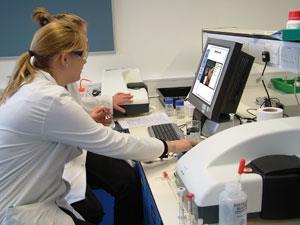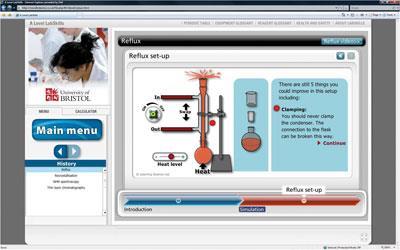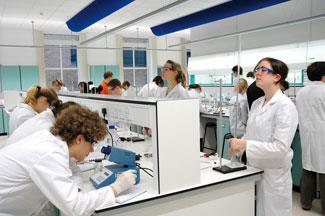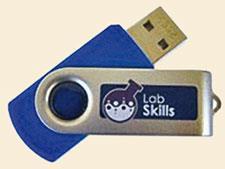The University of Bristol's innovative teaching labs are marketing their electronic laboratory manuals around the world. Emma Davies reports on an education success story
The University of Bristol’s innovative teaching labs are marketing their electronic laboratory manuals around the world. Emma Davies reports on an education success story
I’m feeling nervous. I’m back in the chemistry teaching labs, about to do a recrystallisation after many years away from the bench. I’m getting flashbacks to the trembling hands that marked my very first day in the undergraduate teaching labs at the University of Bristol. The labs look much the same from the outside, but inside they couldn’t be more different. For starters, the recrystallisation is on a screen in front of me and is for practice; it doesn’t matter if it goes horribly wrong. I am experiencing the calm and reassurance of virtual chemistry.

All of Bristol’s chemistry undergraduates have to run through virtual versions of experiments before doing them for real in the labs. It is all part of the Dynamic Lab Manual (DLM), designed by Bristol’s school of chemistry after it was assigned as a Centre for Excellence in Teaching and Learning (CETL) by the Higher Education Funding Council for England (Hefce). The DLM may have started out as a Bristol chemistry teaching tool but has now taken on a life of its own, adopted and adapted by other Bristol departments and sold in various forms to schools and universities around the world.
The teaching labs have changed beyond recognition since my undergraduate days. Most notable is the absence of any chemical smells. The air is regularly refreshed and giant ’aerodynamically efficient’ fume cupboards whisk away any unpleasant odours. There aren’t even any Bunsen burners. Also, there are no solvent-stained lab manuals, simply an array of PCs - as many as one per student in some parts of the lab - which students use to guide themselves through experiments and to enter and analyse lab data. Students can log into the electronic system from anywhere, even from a phone in the corner of a pub. The analytical equipment - including gas chromatographs (GCs), GC-mass spectrometers and high-performance liquid chromatographs, - is state of the art, partly due to a sponsorship deal that sees a company name emblazoned on the wall.
Hefce initially provided about ?5 million over a period of 5 years to fund both the physical facility and the teaching and learning methods to be used in the teaching labs, which reopened in 2007 as Bristol ChemLabS. Staff at the school of chemistry were involved in every detail of the redesign. ’We spent a lot of time working with architects, builders and contractors to get exactly what we wanted,’ says Nick Norman, ChemLabS chief executive.
’We took the opportunity to rethink absolutely everything we did, including all of the experiments. The whole ethos of what we wanted to do in the labs changed,’ adds Norman. The redesign included merging the inorganic, physical and organic labs and a new focus on teaching students essential lab skills rather than simply covering material taught in lectures. Staff also decided to change radically the lab assessment practices. As in most teaching labs, students had long been assessed using the post-lab write-up. ’It was a long, laborious process which neither students nor staff particularly liked,’ says Norman. ’Also, fundamentally, we thought it was not the best way to assess laboratory work.’
Now, before even donning lab coats, students are assessed online using the carefully designed electronic lab manual. Then, when they get to the real lab their practical skills and knowledge are assessed by staff demonstrators.
ChemLabS developed the DLM with a local e-learning consultancy firm called Learning Science, and student focus groups had a very significant input to the design process. Feedback from the first students to enter the labs was very positive, recalls Norman. ’We were happy that we had done something that we thought was right and looked great and that was also having a very positive impact on the students themselves.’
Clean chemistry
By the end of the day before the lab class, students must go through the DLM’s online training and assessment for a particular experiment. First, they have to get a score of at least 80 per cent in a safety test before being granted access to the lab. Demonstrators can access answers to discover where students may have gone wrong and then give targeted feedback.
The undergraduates also work through background information about the experiments and answer multiple choice questions, with instant feedback on any incorrect answers and a chance to have another go with a related question. A large question bank means that no two students will have exactly the same set of questions.

Students set up virtual equipment such as rotary evaporators and reflux systems, dragging and dropping pieces of kit and twiddling dials to turn on taps and adjust temperatures. Techniques are also illustrated step-by-step with video footage recorded in the labs. These silent videos can be accessed on the bench during lab sessions, removing any excuse for plaguing stores staff and demonstrators with confused demands.
’Importantly, the DLM doesn’t in any way replace what students do in the lab but it prepares them for it, allowing them to make (and correct) the common mistakes online,’ says Norman. ’In the old days you would ask a student what they were doing and they would point to the lab manual and say: "well, I’m here, doing that",’ he says. ’Now they might say: "I’m doing a Diels-Alder reaction but I might get two different products and I’ve got to check them using TLC [thin layer chromatography]". It’s like talking to a proper scientist.’

Spread the word
Part of Hefce’s plan was that the Bristol CETL would become a national teaching resource. ChemLabS staff have indeed been busy spreading the word about the new practical chemistry teaching methods. ’We have done quite a bit of dissemination of what we have achieved to the higher education community in chemistry through meetings and presentations,’ says Norman.
Other departments at the university are also starting to see the benefits of the DLM. The biochemistry department has already set up its own DLM for first year students and is developing another for its second year labs. Another CETL at Bristol - applied and integrated medical sciences - has similar software which it uses in clinical anatomy teaching, and has also developed a virtual microscope and human patient simulators. This month, first year physiology and pharmacology students will also get their own DLM.
Chemistry’s DLM has taken on new incarnations since the original undergraduate version. It has proved valuable in post-graduate training at Bristol’s Doctoral Training Centres (DTCs) - set up by Engineering and Physical Sciences Research Council (EPSRC) to manage the PhDs they fund. Bristol has two DTCs: one for chemical synthesis, housed in the chemistry department, and another for functional nanomaterials run jointly by the physics and chemistry departments. Key to the DTCs is a broad first year of training, and the DLM formed a key part of the bid to win funding for the chemical synthesis DTC. ’We subsequently found out that EPSRC viewed that in a very positive way,’ says Norman. The DLM now provides an interactive way for doctoral students to learn about and practise advanced techniques such as x-ray crystallography, nuclear magnetic resonance (NMR) and protein synthesis.
Reaching out
ChemLabS also has a successful and extensive schools outreach programme, which as many as 30 000 children benefit from each year. ’It was always our aim to use the labs when our undergraduates are not here - we don’t want them sitting vacant for 6 months of the year,’ says Norman. Tim Harrison, a former local school teacher, runs the outreach programme and has seen clear benefits for chemistry as a whole. ’At certain schools the number of students choosing to study chemistry has gone from a handful to dozens,’ he says.
This use of the labs to support outreach activities was part of the smarter use of labs strand of the Chemistry for our Future programme, explains Norman. The programme, designed to ensure a sustainable chemical science base within higher education, was funded by Hefce and managed by the RSC.
ChemLabS aims to run the outreach programme ’almost as a business, so that it is financially sustainable’, says Norman. ’With funding being what it is at the moment, we need it to raise its own income and we’re confident that we can do that,’ he adds. Financial independence will allow the programme to run every year, regardless of when any fixed-term funding expires. Such continuity is crucial to schools. The ChemLabS outreach programme has already won a Big Tick award in the education category from Business in the Community for 2 years running, and is the only university department ever to win such an award. Business in the Community is an organisation that works with firms to build a sustainable future, and the awards recognise companies that have shown innovation, creativity and a sustained commitment to corporate responsibility.
Technology for schools

Harrison was quick to recognise the DLM’s potential for school teachers. Together with Learning Science, ChemLabS staff used the DLM methodology to create a package for A-level chemistry students called LabSkills, which is sold to schools. Under an initiative called Discover LabSkills, funded by the RSC and pharmaceutical firm Pfizer, LabSkills is also available free to all UK state and independently funded secondary schools and further education colleges (see the links at the bottom of page for more details).
Harrison, together with Dudley Shallcross, former ChemLabS outreach director, recently raised funding from the Higher Education Academy (a UK organisation that supports teaching and teachers) to develop a LabSkills version for other sciences, as part of a national programme. ’LabSkills has been a fantastic programme and continues to go from strength to strength in terms of the impact we have had on teaching and learning generally,’ says Norman.
In a bid to take the practical skills taught by the DLM to a wider audience, ChemLabS also added extra content to LabSkills to create Foundation LabSkills, targeted at first year chemistry undergraduate students. It is now sold as a one-off networkable package. ’There’s a lot of overlap between basic skills at A-level and basic skills at first year degree level,’ explains Norman.
ChemLabS now sells LabSkills and Foundation LabSkills around the world. The software is proving popular in South Africa and has sold as far afield as Afghanistan and Uganda. The benefits of such technology in countries where lab chemicals and equipment are hard to come by are clear to see.
’Technology has so much to offer but you have to be careful with it, to think about how you use it,’ says Norman. ’There’s nothing wrong with a lecturer using a blackboard and a piece of chalk. Chemical structures are a classic example - we still want students to be able to draw structures carefully and accurately.’ The DLM simply adds to traditional teaching.
I never did get my hands on any real chemicals in the lab on my visit to ChemLabS, which is probably just as well as it has been a few years since I handled a test tube. That privilege was reserved for the primary school children set to visit the next day to discover the joys of perfume chemistry. With any luck, they will be experiencing the DLM themselves in years to come.
Emma Davies is a freelance science writer based in Bishop’s Stortford, UK
Also of interest







No comments yet